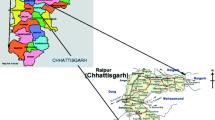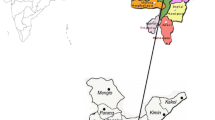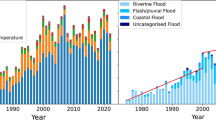Abstract
Extreme rainfall data are widely used in several hydrological models and civil engineering design. Despite high temporal resolution rainfall data are not commonly available, daily rainfall data series are easily found. When these available data series are short in length the Regional Frequency Analysis (RFA) is a good tool to enlarge them by joining stations into homogeneous regions. This is by far, the most complicated step in RFA. This work presents a new method to form homogeneous regions of extreme annual daily rainfall data series. Daily rainfall data series from 53 weather stations in the Maule Region (Chile) have been used. Their fractal dimensions spectra have been obtained by applying the box counting method. Each station has been characterized by the fractal dimensions D1 and D2. A cluster analysis has been carried out based on these at-site characteristics and three regions have been obtained. After performing a RFA of extreme daily annual rainfall data series within each region they have shown as homogeneous. Only one of the available stations has not been possible to be included into any homogeneous regions, being the local frequency analysis the only suitable method to be applied at this location.




Similar content being viewed by others
References
Ariza-Villaverde AB, Jiménez-Hornero FJ, Gutiérrez de Ravé E (2013) Multifractal analysis applied to the study of the accuracy of DEM-based stream derivation. Geomorphology 197:85–95
Bonell M, Sumner G (1992) Autumn and winter daily precipitation areas in Wales, 1982–1983 to 1986–1987. Int J Climatol 12:77–102
Burn DH (1989) Cluster analysis as applied to regional flood frequency. J Water Resour Plan Manag 115:567–582
Castellarin A, Burn DH, BrathA (2001) Assessing the effectiveness of hydrological similarity measures for flood frequency analysis. J Hydrol 241(3–4):270–285
Castellarin A, Merz R, Blöschl G (2009) Probabilistic envelope curves for extreme rainfall events. J Hydrol 378:263–271
Davis A, Marshak A, Wiscombe W, Cahalan R (1994) Multifractal characterization of non stationarity and intermittency in geophysical fields: observed, retrieved or simulated. Journal of Geophysical Resources 99:8055–8072
De Bartolo SG, Gabriele S, Gaudio R (2000) Multifractal behavior of river networks. Hydrology and Earth Sciences 4(1):105–112
de Lima MIP, Grasman J (1999) Multifractal analysis of 15-min and daily rainfall from a semi-arid region in Portugal. J Hydrol 220:1–11
Di Baldassarre G, Brath A, Montanari A (2006) Reliability of different depth-duration-frequency equations for estimating short-duration design storms. Water Resour Res 42:W12501. doi:10.1029/2006WR004911
Dinpashoh Y, Fakheri-Fard A, Moghaddam M, Jahanbakhsh S, Mirnia M (2004) Selection of variables for the purpose of regionalization of Iran’s precipitation climate using multivariate methods. J Hydrol 297:109–123
Easterling DR (1989) Regionalization of thunderstorm rainfall in the contiguous United States. Int J Climatol 9:567–579
Estévez J, Gavilán P, García-Marín AP (2011a) Data validation procedures inagricultural meteorology. A prerequisite for their use. Adv Sci Res 6:141–146
Estévez J, Gavilán P, Giráldez JV (2011b) Guidelines on validation procedures for meteorological data from automatic weather stations. J Hydrol 402:144–154
Feder J (1988) Fractals. Plenum, New York
Feeny BF (2000) Fast multifractal analysis by recursive box covering. International Journal of Bifurcation and Chaos in Applied Sciences and Engineering 10(9):2277–2287
Feng S, Hu Q, Qian Q (2004) Quality control of daily meteorological data in China, 1951–2000: a new dataset. Int J Climatol 24:853–870
Fowler HJ, Kilsby CG (2003) A regional frequency analysis of United Kingdom extreme rainfall from 1961 to 2000. Int J Climatol 23:1313–1334
Gadgil S, Joshi Y, Joshi NV (1993) Coherent rainfall zones of the Indian region. Int J Climatol 13:547–566
García Marín AP, Estévez J, Medina Cobo MT, Ayuso Muñoz JL (2015b) Delimiting homogeneous regions using the multifractal properties of validated rainfall data series. J Hydrol 529:106–119
García-Marín AP, Ayuso-Muñoz JL, Taguas Ruiz EV, Estévez J (2011) Regional analysis of the annual maximum daily rainfall in the province of Málaga (southern Spain) using the principal component analysis. Water and Environmental Journal 25(4):522–531
García-Marín AP, Ayuso-Muñoz JL, Jiménez-Hornero FJ, Estévez J (2013) Selecting the best IDF model by using the multifractal approach. Hydrol Process 27:433–443
García-Marín AP, Estévez J, Sangüesa-Pool C, Pizarro-Tapia R, Ayuso-Muñoz JL, Jiménez-Hornero FJ (2015a) The use of the exponent K(q) function to delimit homogeneous regions in regional frequency analysis of extreme annual daily rainfall. Hydrol Process 29:139–151
Grassberger P (1983) Generalized dimensions of strange attractors. PhysicsLetter A 97:227–230
Grassberger P, Procaccia I (1983) Measuringthestrangeness of strangeattractors. Physica D 9:189–208
Greenwood J, Landwehr J, Matalas N, Wallis J (1979) Probability weighted moments: definition and relation to parameters of several distributions expressed in inverse form. Water Resour Res 15(6):1049–1054
Greis NP, Wood EF (1981) Regional flood frequency estimation and network design. Water Resour Res 17(4). doi:10.1029/WR017i004p01167
Hall MJ, Minns AW (1999) The classification of hydrological homogeneous regions. Journal of Hydrological Science 44(5):693–704
Halsey TC, Jensen MH, Kadanoff LP, Procaccia I, Shraiman BI (1986) Fractal measures and their singularities: the characterization of strange sets. Phys Rev A 33:1141–1151
Hentschel HGE, Procaccia I (1983) The infinite number of generalized dimensionsof fractals and strange attractors. Physica D: Nonlinear Phenomena 8:435–444
Hosking JRM (1990) L-moments: analysis and estimation of distributions using linear combinations of order statistics. Journal of Royal Statistical Society B 52:105–124
Hosking JRM (1992) Moments or L-moments? An example comparing two measures of distributional shape. The American Statiscian 46(3):186–189
Hosking JRM, Wallis JR (1993) Some statistics useful in regional frequency analysis. Water Resour Res 29(1):271–281
Hosking JRM, Wallis JR (1995) Correction to “some statistics useful in regional frequency analysis”. Water Resour Res 31(1):251
Hosking JRM, Wallis JR (1997) Regional frequency analysis-an approach based on L-moments. Cambridge University Press, Cambridge
Hosking JRM, Wallis JR, Wood EF (1985a) An appraisal of the regional flood frequency procedure in the UK flood studies report. Hydrol Sci J 30:85–109
Hubbard KG, Goddard S, Sorensen WD, Wells N, Osugi TT (2005) Performance of qualityassuranceproceduresforanappliedclimateinformationsystem. J Atmos Ocean Technol 22:105–112
Jingyi Z, Hall MJ (2004) Regional flood frequency analysis for Gan-Ming river basin in China. J Hydrol 296:98–117
Kravchenko AN, Boast CW, Bullock DG (1999) Multifractal analysis of soil spatialvariability. Agron J 91:1033–1041
Kunkel KE, Easterling DR, Hubbard K, Redmond K, Andsager K, Kruc MC, Spinar ML (2005) Quality control of pre-1948 cooperative network observer data. Journal Atmospherie and Oceanic Technology 22:1691–1705
Kyselý J, Picek J, Huth R (2007) Formation of homogeneous regions for regional frequency analysis of extreme precipitation events in the Czech Republic. Stud Geophys Geod 51:327–344
Lecce SA (2000) Spatial variations in timing of annual floods in the southeastern United States. J Hydrol 235:151–169
Lee SH, Maeng SJ (2005) Estimation of drought rainfall using L-moment. Irrig Drain 54:279–294
Lettenmaier DP, Potter KW (1985) Testing flood frequency estimation methods using a regional flood generating model. Water Resour Res 21(12):190–1914
Liu J, Doan CD, Shie-Yui L, Sanders R, Dao AT, Fewtrell T (2015) Regional frequency analysis of extreme rainfall events in Jakarta. Nat Hazards 75:1075–1104
Maity AK, Pratihar R, Mitra A, Dey S, Agrawal V, Sanyal S, Banerjee A, Sengupta R, Ghosh D (2015) MultifractalDetrended fluctuation analysis of alpha and theta EEG rhythms with musical stimuli. Chaos, Solitons and Fractals 81:52–67
Malekinezhad H, Zare-Garizi A (2014) Regional frequency analysis of daily rainfall extremes using L-moments approach. Atmósfera 27(4):411–427
Mandelbrot BB (1982) The fractal geometry of nature. Freeman, New York
Meshgi A, Khalili D (2009) Comprehensive evaluation of regional flood frequency analysis by L- and LH-moments. I A re-visit to regional homogeneity Stochastic Environmental Research and Risk Assesment 23(1):119–135
Ngongondo CS, Xu CY, Tallaksen LM, Alemaw B, Chirwa T (2011) Regional frequency analysis of rainfall extremes in southern Malawi using the index rainfall and L-moments approaches. Stoch Env Res Risk A 25:939–955
Norbiato D, Borga M, Sangati M, Zanon F (2007) Regional frequency analysis of extreme precipitation in the eastern Italian alps and the august 29, 2003 flash flood. J Hydrol 345:149–166
Rao AR, Hamed KH (2000) Flood frequency analysis. CRC Press, Boca Raton
Saa A, Gasco G, Grau JB, Anton JM, Tarquis AM (2007) Comparison of gliding box and box counting methods in river network analysis. Nonlinear Process Geophys 14:603–613
Satyanarayana P, Srinivas VV (2011) Regionalization of precipitation in data sparse areas using large scale atmospheric variables - a fuzzy clustering approach. J Hydrol 405:462–473
Serrano S, Perán F, Jiménez-Hornero FJ, Gutiérrez de Ravé E (2013) Multifractal analysis application to the characterization of fatty infiltration in Iberianand white pork sirloins. Meat Sci 93:723–732
Shabri AB, Daud ZM, Ariff NM (2011) Regional analysis of annual maximum rainfall using TL-moments method. Theor Appl Climatol 104:561–570
Srinivas VV, Tripathi S, Rao AR, Govindaraju RS (2008) Regional flood frequency analysis by combining self-organizing feature maps and fuzzy clustering. J Hydrol 348:148–166
Telesca L, Lovallo M. (2011). Analysis of time dynamics in Wind records by means of multifractal detrended fluctuation analysis and Fisher-Shannon information plane. J Stat Mech: Theory Exp P07001. doi:10.1088/1742-5468/2011/07/P07001
Telesca L, Colangelo G, Lapenna V, Macchiato M (2004) Fluctuation dynamics in geoelectrical data: aninvestigationbyusingmultifractaldetrendedfluctuationanalysis. PhysicsLetters A 332:398–404
Venkatesh B, Jose M (2007) Identification of homogeneous rainfall regimes in parts of western Ghats region of Karnataka. Journal of Earth System Science 116:321–329
Viglione A, Laio F, Claps P (2007) A comparison of homogeneity tests for regional frequencyanalysis. Water Resour Res 43:W03428. doi:10.1029/2006WR005095
Wallis JR, Wood EF (1985) Grouping basins for regional flood frequency analysis. Hydrol Sci J 30:151–159
Wallis JR, Schaefer MG, Barker BL, Taylor GH (2007) Regional precipitation-frequency analysis and special mapping for 24-hour and 2-hour durations for Washington state. Hydrol Earth Syst Sci 11(1):415–442
Yürekli K, Modarres R (2007) Regionalization of maximum daily rainfall data over Tokat province, Turkey. Int J Nat Eng Sci 1(2):1–7
Zahumensky I. (2004). Guidelines on Quality Control Procedures for Data from Automatic Weather Stations.WMO-No. 955. Geneva
Acknowledgements
We applied the ‘sequence-determines-credit’ (SDC) approach for the sequence of authors. The authors also want to thank the CTHA (Chile) and the DGA (Chile) for providing meteorological data to carry out this work. F.J. Jimenez-Hornero gratefully acknowledges the support from ERDF Project CGL2014-54615-C2-1-R (Spanish Ministry of Economy and Competitiveness).
Author information
Authors and Affiliations
Corresponding author
Rights and permissions
About this article
Cite this article
Medina-Cobo, M.T., García-Marín, A.P., Estévez, J. et al. Obtaining Homogeneous Regions by Determining the Generalized Fractal Dimensions of Validated Daily Rainfall Data Sets. Water Resour Manage 31, 2333–2348 (2017). https://doi.org/10.1007/s11269-017-1653-2
Received:
Accepted:
Published:
Issue Date:
DOI: https://doi.org/10.1007/s11269-017-1653-2




